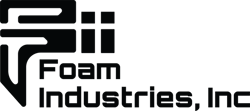What is ILD/IFD and Why Does it Matter for Packaging?
Packaging foam needs to keep your products safe from damage during transit. ILD/IFD is a critical element for ensuring this protection - but what does it mean? And why does it matter?
Let’s delve into ILD/IFD to explore why it is a crucial consideration for effective packaging solutions.
What is ILD/IFD?
Indentation load deflection (ILD) and indentation force deflection (IFD) are both the same thing - it measures how much force it takes to compress a foam down to a reduced thickness. Typically, this is down to 25% of its thickness. You’ll often see one term or the other used interchangeably, so we’ll continue to reference both moving forward.
A few things to keep in mind with ILD/IFD. First: it’s not a unit of measurement in the same way that density or weight are measured - so something like “35 ILD” doesn’t really mean anything. It’s not a uniform, universal measurement.
Instead, you would typically measure and notate ILD/IFD like this: “10 pounds of pressure to compress a foam to 25%.” It’s important to look for both the force applied and the thickness in any ILD/IFD data, as this is not standardized. Some companies, for example, measure ILD/IFD at 65% and not 25%.
So if you only saw “a rating of 10 pounds ILD,” without further context there’s no real meaning to that number. You need to look for both the force applied and the thickness.
You most commonly see ILD/IFD applied to foam mattresses - as this helps contextualize the softness or firmness - but this measurement is used across different types of foam applications.
Why Does it Matter for Packaging?
Now back to packaging, and how all this matters for shipping items. There are two primary considerations.
First, is the internal pressure of an item against its foam case insert. In other words, if your part weighs 20 pounds, you don’t want a foam that will compress to 65% under 10 pounds of pressure! You want to choose a foam where the ILD/IFD measures enough to adequately support your product.
Secondly is the external pressure an item may receive. How will this item be shipped? Will it be stacked with items in one box? Will the box be loaded on a palette with other boxes? Your foam packaging may experience external forces of pressure, so it’s important to ensure that it can withstand that as well.
Find Your Best Option with a Packaging Expert
The best way to tackle ILD/IFD is to work with a foam packaging expert who can tell you the exact right foam to use for your product and application.
As a leader in the packaging industry, Foam Industries has set the bar with an unwavering commitment to quality, exceptional client service, and constant innovation. Through our extensive inventory of endlessly customizable products, we ensure you find exactly what you’re looking for.
Foam Industries is a custom protective packaging company specializing in foam – with additional wood and plastic fabrication services. Our custom foam fabrication services are ideal for any type of packaging, display, or support service needed – from design to finished product.
Get a Quote
Ensure your product(s) arrive from A to B, damage-free. Foam Industries will optimize your protective packaging. The results? Less damage, better bottom line.
